
Dec . 11, 2024 08:03
Back to list
high pressure regulators
Understanding High Pressure Regulators Essential Components for Safe and Efficient Gas Management
High pressure regulators are crucial devices used in a variety of settings, including industrial, commercial, and laboratory environments. Their primary function is to control the pressure of gases from high-pressure cylinders or tanks, ensuring that they are delivered at a consistent, safe pressure. This article delves into the significance, working principles, applications, and maintenance of high-pressure regulators.
What are High Pressure Regulators?
High pressure regulators are specialized valves designed to reduce and regulate the pressure of gas supplied from a high-pressure source. These regulators are engineered to handle pressures often ranging from a few psi (pounds per square inch) to several thousand psi, depending on the application and the type of gas being utilized. They are essential for preventing equipment damage and ensuring the safety of operations involving compressed gases.
How Do High Pressure Regulators Work?
The operation of high-pressure regulators is based on the principles of mechanics and fluid dynamics. Essentially, a regulator consists of several key components
1. Inlet and Outlet Ports The inlet port connects to the high-pressure gas source, while the outlet port supplies the gas at a controlled, lower pressure.
2. Diaphragm or Piston This component responds to changes in outlet pressure. When the pressure rises above the set point, the diaphragm moves to reduce gas flow; conversely, it allows increased flow when the pressure drops below the desired level.
3. Spring Mechanism A spring applies pressure on the diaphragm, determining the set point of the regulator. This balance between the gas pressure and the spring pressure is what maintains the desired output pressure.
4. Adjustable Set Point Many high-pressure regulators come with an adjustable set point, enabling operators to customize the output pressure according to specific needs.
The regulator continually responds to changes in both input and output pressure, ensuring that the gas flow remains stable and within safe limits.
Applications of High Pressure Regulators
High pressure regulators find applications across various industries. Some common uses include
high pressure regulators

2. Industrial Manufacturing Many manufacturing processes rely on compressed gases. Regulators help maintain the correct pressure for pneumatic systems, ensuring smooth operation.
3. Laboratory Experimentation In controlled environments, precise gas pressure is often required for experiments. High pressure regulators ensure consistent delivery of gases for various applications, including chromatography and chemical reactions.
4. Medical Facilities High pressure regulators are used with medical gases such as oxygen and nitrous oxide. Safety and accuracy in pressure delivery are critical in healthcare settings.
Maintenance of High Pressure Regulators
To ensure the longevity and reliability of high pressure regulators, regular maintenance is essential. Here are some tips for proper upkeep
1. Routine Inspections Regularly check regulators for signs of wear, damage, or leakage. Look for corrosion, particularly in the metallic components.
2. Cleaning Keep the regulator clean, especially the inlet and outlet ports, to prevent blockages and ensure consistent performance.
3. Calibration Periodically calibrate the regulator to ensure that it provides accurate pressure readings.
4. Replace Worn Parts If any internal components show signs of wear or failure, they should be replaced to avoid malfunctions and ensure safety.
Conclusion
High pressure regulators are indispensable tools in the safe management of gases across various industries. Understanding their function, applications, and maintenance needs is crucial for anyone working with high-pressure gas systems. By ensuring these regulators are properly maintained and adjusted, operators can ensure safety, efficiency, and reliability in their operations. As industries continue to evolve and demand higher precision and safety, high pressure regulators will remain a fundamental component in the management of gas systems.
Next:
Latest news
-
Safety Valve Spring-Loaded Design Overpressure ProtectionNewsJul.25,2025
-
Precision Voltage Regulator AC5 Accuracy Grade PerformanceNewsJul.25,2025
-
Natural Gas Pressure Regulating Skid Industrial Pipeline ApplicationsNewsJul.25,2025
-
Natural Gas Filter Stainless Steel Mesh Element DesignNewsJul.25,2025
-
Gas Pressure Regulator Valve Direct-Acting Spring-Loaded DesignNewsJul.25,2025
-
Decompression Equipment Multi-Stage Heat Exchange System DesignNewsJul.25,2025

